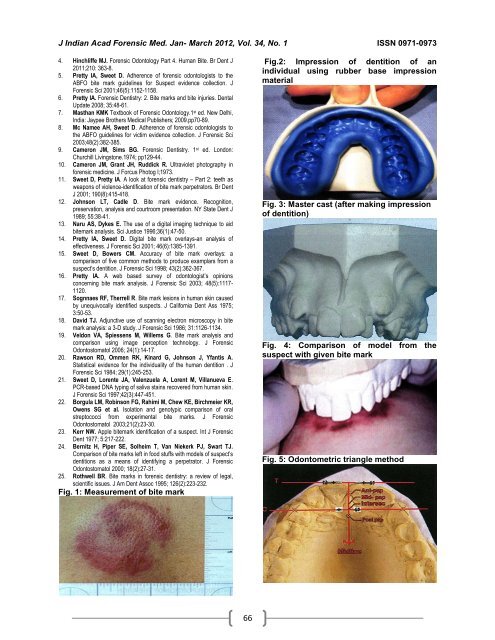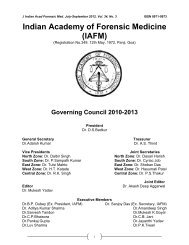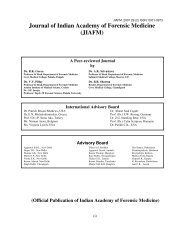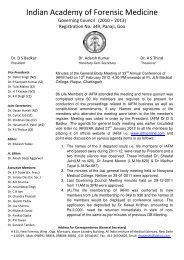Indian Academy of Forensic Medicine (IAFM) - Official website of IAFM
Indian Academy of Forensic Medicine (IAFM) - Official website of IAFM
Indian Academy of Forensic Medicine (IAFM) - Official website of IAFM
You also want an ePaper? Increase the reach of your titles
YUMPU automatically turns print PDFs into web optimized ePapers that Google loves.
J <strong>Indian</strong> Acad <strong>Forensic</strong> Med. Jan- March 2012, Vol. 34, No. 1 ISSN 0971-0973<br />
4. Hinchliffe MJ. <strong>Forensic</strong> Odontology Part 4. Human Bite. Br Dent J<br />
2011;210: 363-8.<br />
5. Pretty IA, Sweet D. Adherence <strong>of</strong> forensic odontologists to the<br />
ABFO bite mark guidelines for Suspect evidence collection. J<br />
<strong>Forensic</strong> Sci 2001;46(5):1152-1158.<br />
6. Pretty IA. <strong>Forensic</strong> Dentistry: 2. Bite marks and bite injuries. Dental<br />
Update 2008; 35:48-61.<br />
7. Masthan KMK Textbook <strong>of</strong> <strong>Forensic</strong> Odontology.1 st ed. New Delhi,<br />
India: Jaypee Brothers Medical Publishers; 2009.pp70-89.<br />
8. Mc Namee AH, Sweet D. Adherence <strong>of</strong> forensic odontologists to<br />
the ABFO guidelines for victim evidence collection. J <strong>Forensic</strong> Sci<br />
2003;48(2):382-385.<br />
9. Cameron JM, Sims BG. <strong>Forensic</strong> Dentistry. 1 st ed. London:<br />
Churchill Livingstone.1974; pp129-44.<br />
10. Cameron JM, Grant JH, Ruddick R. Ultraviolet photography in<br />
forensic medicine. J Forcus Photog I;1973.<br />
11. Sweet D, Pretty IA. A look at forensic dentistry – Part 2: teeth as<br />
weapons <strong>of</strong> violence-identification <strong>of</strong> bite mark perpetrators. Br Dent<br />
J 2001; 190(8):415-418.<br />
12. Johnson LT, Cadle D. Bite mark evidence. Recognition,<br />
preservation, analysis and courtroom presentation. NY State Dent J<br />
1989; 55:38-41.<br />
13. Naru AS, Dykes E. The use <strong>of</strong> a digital imaging technique to aid<br />
bitemark analysis. Sci Justice 1996;36(1):47-50.<br />
14. Pretty IA, Sweet D. Digital bite mark overlays-an analysis <strong>of</strong><br />
effectiveness. J <strong>Forensic</strong> Sci 2001; 46(6):1385-1391.<br />
15. Sweet D, Bowers CM. Accuracy <strong>of</strong> bite mark overlays: a<br />
comparison <strong>of</strong> five common methods to produce examplars from a<br />
suspect’s dentition. J <strong>Forensic</strong> Sci 1998; 43(2):362-367.<br />
16. Pretty IA. A web based survey <strong>of</strong> odontologist’s opinions<br />
concerning bite mark analysis. J <strong>Forensic</strong> Sci 2003; 48(5):1117-<br />
1120.<br />
17. Sognnaes RF, Therrell R. Bite mark lesions in human skin caused<br />
by unequivocally identified suspects. J California Dent Ass 1975;<br />
3:50-53.<br />
18. David TJ. Adjunctive use <strong>of</strong> scanning electron microscopy in bite<br />
mark analysis: a 3-D study. J <strong>Forensic</strong> Sci 1986; 31:1126-1134.<br />
19. Veldon VA, Spiessens M, Willems G. Bite mark analysis and<br />
comparison using image perception technology. J <strong>Forensic</strong><br />
Odontostomatol 2006; 24(1):14-17.<br />
20. Rawson RD, Ommen RK, Kinard G, Johnson J, Yfantis A.<br />
Statistical evidence for the individuality <strong>of</strong> the human dentition . J<br />
<strong>Forensic</strong> Sci 1984; 29(1):245-253.<br />
21. Sweet D, Lorente JA, Valenzuela A, Lorent M, Villanueva E.<br />
PCR-based DNA typing <strong>of</strong> saliva stains recovered from human skin.<br />
J <strong>Forensic</strong> Sci 1997;42(3):447-451.<br />
22. Borgula LM, Robinson FG, Rahimi M, Chew KE, Birchmeier KR,<br />
Owens SG et al. Isolation and genotypic comparison <strong>of</strong> oral<br />
streptococci from experimental bite marks. J <strong>Forensic</strong><br />
Odontostomatol 2003;21(2):23-30.<br />
23. Kerr NW. Apple bitemark identification <strong>of</strong> a suspect. Int J <strong>Forensic</strong><br />
Dent 1977; 5:217-222.<br />
24. Bernitz H, Piper SE, Solheim T, Van Niekerk PJ, Swart TJ.<br />
Comparison <strong>of</strong> bite marks left in food stuffs with models <strong>of</strong> suspect’s<br />
dentitions as a means <strong>of</strong> identifying a perpetrator. J <strong>Forensic</strong><br />
Odontostomatol 2000; 18(2):27-31.<br />
25. Rothwell BR. Bite marks in forensic dentistry: a review <strong>of</strong> legal,<br />
scientific issues. J Am Dent Assoc 1995; 126(2):223-232.<br />
Fig. 1: Measurement <strong>of</strong> bite mark<br />
66<br />
Fig.2: Impression <strong>of</strong> dentition <strong>of</strong> an<br />
individual using rubber base impression<br />
material<br />
Fig. 3: Master cast (after making impression<br />
<strong>of</strong> dentition)<br />
Fig. 4: Comparison <strong>of</strong> model from the<br />
suspect with given bite mark<br />
Fig. 5: Odontometric triangle method









